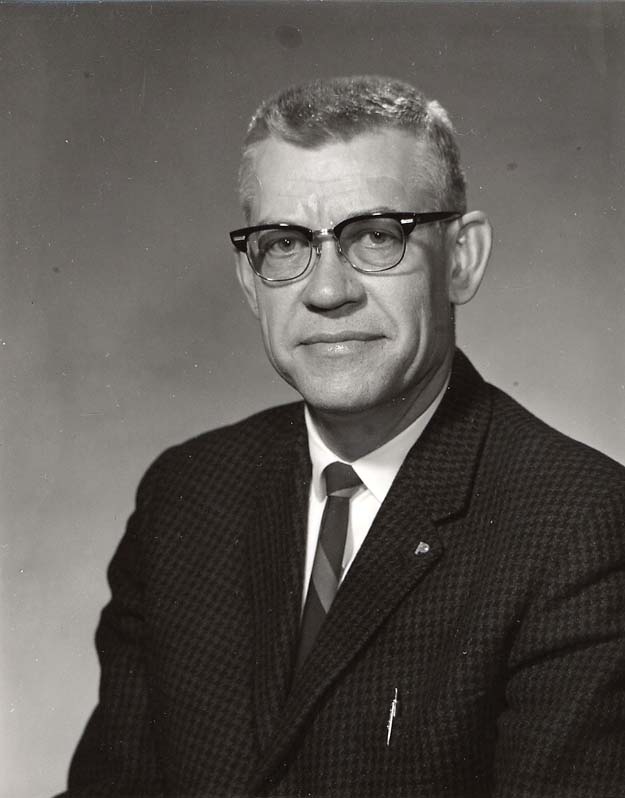‘Legendary’ ISU journalism leader Schwartz remembered for passion, dedication
Photo courtesy of Greenlee School of Journalism and Communication
James Schwartz, a renowned leader and chairman of the ISU journalism program from 1966 to 1977, died at the age of 95 in Edina, Minn. on July 12.
July 18, 2011
As chairman of the journalism program at Iowa State from 1966 to 1977, James W. “Jim” Schwartz, who died last week at the age of 95, oversaw one of the biggest periods of growth and tumult in the program’s history, and is remembered as a great and passionate leader and journalist.
Tom Emmerson, professor emeritus of journalism, described Schwartz, who died in Edina, Minn. on July 12 with his wife of 70 years and family by his side, as “a great champion of the First Amendment.”
“He had a really great presence,” Emmerson said. “He was inspiring, and he made people come up to high marks.”
Services will be held 3 p.m. Saturday at Mount Olivet Lutheran Church in Minneapolis. A burial and memorial gathering in Ames is set for early September.
Born in 1915 in Fenton, Schwartz worked at newspapers in Fenton, Denison, Harlan and Rockwell City, as well as serving as editor in chief of the Iowa State Daily, before joining the Army in 1945.
After contracting tuberculosis, which eventually left him with one functioning lung, he returned to Ames as an assistant professor of journalism to work at WOI radio and television. At WOI, he became a broadcast pioneer, hosting the first weekly interview television show in Iowa.
In 1963, one of his Journalism 101 students was Eric Abbott, now an Iowa State professor. Schwartz continued to be a mentor to Abbott, who eventually served as editor in chief of the Iowa State Daily. When Abbott ended his tenure at the Daily, Schwartz sent him a note reading “Job well done.”
“That was probably the most important praise I’d ever gotten,” Abbott said. In 1974, Schwartz hired both Abbott and Emmerson, also an ISU graduate, as professors.
In 1966, Schwartz became chairman of the program, then called the Department of Technical Journalism. When he took over, the department had about 150 journalism majors. Upon his departure, the program, renamed the Department of Journalism and Mass Communication, had grown to have “six or seven hundred majors,” Abbott said.
Schwartz and his brother, Bob, ran the Iowa State Press in the basement of Hamilton Hall. With the profits from the press, they were able to earn money for multiple additions to the building.
Michael Bugeja, current director of the Greenlee School of Journalism and Mass Communication, called Schwartz “legendary.” He said the man’s achievements in both journalism and journalism education were laudable.
In a speech for the Greenlee School’s centennial celebration in 2005, Emmerson told the story of one of Schwartz’s most memorable moments as department chair. In 1970, amid the Vietnam War backlash taking place on college campuses nationwide, the Iowa State Daily had “begun to overdose,” in the words of its then editor-in-chief, Jack Brimeyer. The paper had come under fire in the community for its ardent support of Vietnam protests and use of the “F-word” on the front page.
But Schwartz, always a fervent champion of the First Amendment and freedom of the press, wrote candidly in that fall’s department newsletter not about fundraising and accolades (as was the custom), but about his support of the Daily and its staff, praising its commitment to quality journalism.
“The four-letter word issue,” Schwartz wrote, “is not by itself one of surpassing significance. It will pass. The need for free expression will not.”
Faculty were grateful for Schwartz’s defense of the program. “It was a great moment when Jim stood tall and brought people to their senses,” Emmerson said.
After the conflict over Vietnam had died down, and the department underwent, in Emmerson’s words, “a period of tremendous growth,” Schwartz stepped down from the chair position in 1977 before retiring in 1979.
As a professor, Schwartz had taken off each summer to spend with his family at their cabin on Ten Mile Lake in Minnesota, the interior of which he built himself. When he retired, he and his wife, Toni, spent most of their time at the cabin, where Schwartz focused on his passions, which included woodworking, fishing, hunting and photography. One of his most notable passions was the lake itself.
Schwartz’s eldest son, Michael, said that his father tested the lake’s temperature and quality daily, and worked to make the lake association “the most effective of them all.” For several decades, he edited the lake’s newsletter. The last piece he wrote for the newsletter was a tribute to his brother, Bob, who passed away in June. He also welded and constructed a boat dock entirely from 50-pound wrought-iron covers he had taken from the old steam tunnels at Iowa State.
But Schwartz never forgot the program he had strengthened at Iowa State.
“He has always interacted with me every few months,” Bugeja said, “to ask whether I am upholding the hard-hat journalism culture that he helped to create here.”
The journalism program at Iowa State benefited immeasurably from the leadership of Jim Schwartz, several who studied and taught under him said. Accordingly, the school has continued to recognize his legacy; its top journalism honor, the James W. Schwartz Award, is named for him.
“Thanks to all that’s gone before,” Emmerson said, “I can say that freedom of speech and of the press are alive and well in Hamilton Hall today.”







